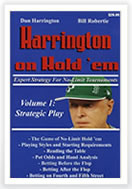 |
Author: Dan Harrington Publisher: Two Plus Two Pages: 381 Pub. Date: 2004 Price: $19.77 |
Book Review: Part 1
| Harrington on Hold ‘em – Expert Strategy for No-limit Tournaments Volume 1: Strategic Play ranks among the best-ever poker strategy offerings. The book focuses on no-limit hold’em tournament play and benefits a wide range of player skills, particularly intermediate level. Its principles also apply to all forms of tournament poker.Harrington Volume I is a comfortable read offering plenty of food for thought, even though the book’s makeup is deceptively simple. After a brief introduction, the material is presented in seven parts: The Game of No-Limit Hold’em; Playing Styles and Starting Requirements; Reading the Table; Pot Odds and Analysis; Betting Before the Flop; Betting After the Flop; and Betting on Fourth or Fifth Street. Each of the sections concludes with a short series of problems reinforcing that section’s basic concepts. Though the concepts and problems are framed within the context of no-limit play and the sections themselves sound mechanical, don’t be fooled: Harrington Volume I is one of the most important conceptual poker-strategy books ever written. It’s a book that’s often as much about people and their styles as the poker itself. It’s a book about leverage, and how that translates into a winning game.After a brief glossary and superficial description of no-limit tourney play, the first section kicks right off with one of its most important concepts – controlling pot odds. Understanding pot odds – that relationship between the chips in your stack, the size of the pot, and your cards’ ultimate chances of winning, is one of the core concepts of the no-limit game. But what Harrington hammers home like few others is the fact that pot odds are a controllable, defining factor in successful tourney play. By knowing the odds in a given situation, by recognizing tantalizing but unworthy traps, and by creating favorable odds yourself (always in consideration of the stack sizes of yourself and your opponents) one can exert a measure of control over a game despite its ever-present chaos of chance. One can’t always dodge the bad beats, but one can help prevent inviting them to occur.Likewise, Harrington’s Volume I quickly established a new industry high in allowing players to think about the entire game as it unfolds, not just themselves and their own hands. One old poker saw says that bad poker players play their own cards, while good poker players play their opponents. Harrington did more here than just explain the difference – he broke it down to its basics, step by step. By way of example, an early section lists, point by point, some of the factors that should be considered during each and every hand. There are eleven points. “What are your cards?” comes in at eleventh. The point that’s hammered home again and again, through the text and accompanying problems, is that a given hand might or might not be playable in any given tourney situation – and often the cards themselves are the least of the matter. |
| Click Here for Part 2! |